Onward with this one. After cutting out, the next two important steps are marking the various pieces and applying the interfacing. At this point I do tailor's tacks for all the dots or other indicating marks.
This photo shows the various interfacings I use on a jacket. While the fabric for this one is a lightweight cotton seersucker, the interfacing is just about the same as I use on a winter wool.
I read somewhere recently (can't recall where) that the difference between home sewing and ready-to-wear clothes is the amount of interfacing. If you open up a better RTW garment you will see interfacing everywhere, hems, pockets, almost every seam junction. I agree with this and use a lot of interfacing, about 90% of which is fusible. I love fusible intefacing, it is like magic! Ok slight exaggeration but it is so useful and like seasonings in cooking - I add different ones based on the fabric, and what part of the garment it is.
For this jacket I interfaced the jacket body front in lightweight weft interfacing. Same on the under collar which you can see in the photo above (top piece with the seam). Weft interfacing is great for tailoring to give body and support. Then I used Sheer Elegance Medium fusible on the upper collar and the upper lapels, and the side front pieces. You can see that I do the tailor's tacks first, while the paper pattern pieces are still attached to the cut fabric. So the thread tailor's tacks do get stuck under the fusible. If I am concentrating I will remember to pull the thread tails away to the edge so I can yank them out easier when finished but I usually don't have trouble removing them. Once in a great while I sew a tricky corner or junction and upon completion there is one stinking thread from a tailor's tack that will not budge so very precise extraction is required. Usually in a very visible spot and in a color that is very distracting. But patience and a tiny tweezers usually do the job.
Now to the pockets. This jacket pattern has a rather tricky welt pocket which incorporates a front vertical dart. I do look at the instructions each time I have used this pattern, just to make sure I don't slice anything before its time.
Here you can see that I put the interfacing on the jacket front, then replaced the paper piece, did the thread tailor's tacks and finally cut out the wedge in order to sew the dart and then make the pocket. If you slice this open before interfacing then you have a flippy-floppy piece that might threaten to unravel or get stretched out of shape. By interfacing first then you can make a nice clean slice with the interfacing covering every fiber.
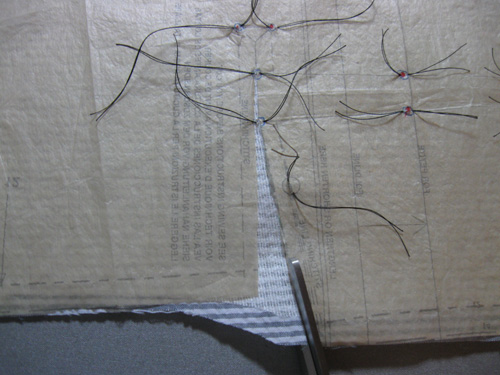
Next step is to sew the vertical dart and attach the side front piece (which is also a bit tricky as the center front pieces have a horizontal slice going in them). To see this pattern piece and the tricky dart/slice feature take a look at this previous post, there is a picture of the front pattern piece.
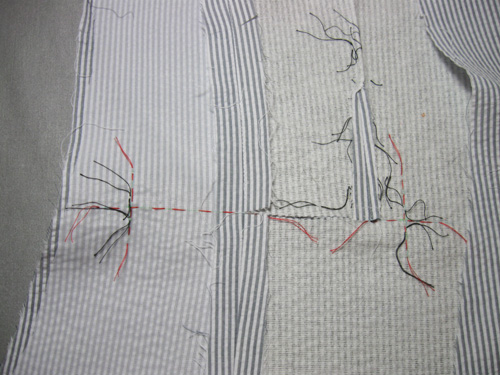
Then I thread trace the welt pocket, both the horizontal line and the vertical lines at the edge, about 2-3 inches for those vertical pieces so when I put the pocket welts on them I can see the end point for stitching. I mark and thread trace on the interfacing side of the jacket but the business side is actually the right side of the fabric, where you will be sewing the pocket welts.
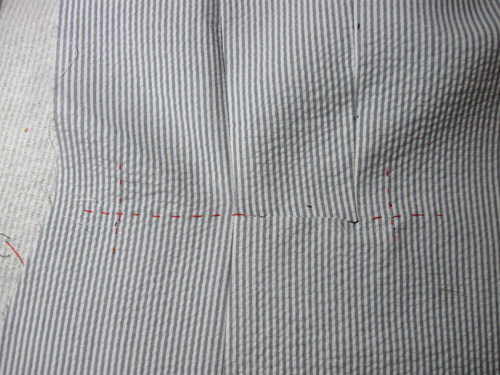
Searching though all my previous posts I don't see one where I took pictures of the welt pocket process, step-by-step but I know there are zillions of tutorials available.
Up next, making the pocket flaps. Yes - a whole post just on pocket flaps. Suprised myself with that one - more involved than I previously realized :)
By the way - some interesting comments on my previous post about pinning vs. pattern weights. Whatever works for you is great. I know a lot of people use a rotary cutter instead of scissors but I will never try the rotary cutter for cutting out a garment. I just can't get the hang of that thing, too clumsy and know I would slice something important like my finger or the center of a pattern piece! So better to stay safe with my nice sharp shears.
Interfacing info: I use various fusible interfacings from Fashion Sewing Supply. The top 3 that I most frequently use are the Pro-Weft Supreme, the Pro-Sheer Elegance, and Pro-Tricot Deluxe.
There is a stack of new patterns waiting to be tried and a few fabrics I want to start on so they can be made into wearable summer garments - however in the summertime is it better to be sewing or out doing things? Outside in this glorious weather almost always wins!
Here's hoping you have a glorious Summer Solstice weekend (or autumn in other parts of the globe)!
Beth
Today's SunnyGal garden photo - gladioli that rebloomed from last year's bulbs. My favorite kind - the repeat performers.
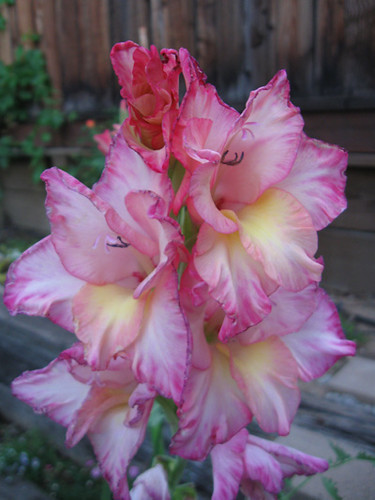

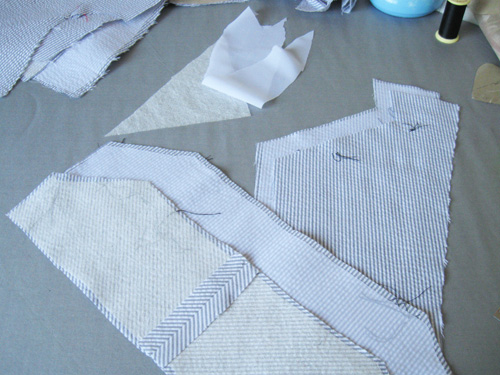










I'm loving your summer blazer series. I have ideas for them for myself. Thanks for talking about interfacing. I've been thinking I need to use heavier interfacing with my seersucker and your post confirms it.
ReplyDeleteYes this is a great series Beth. And really useful to hear about the interfacing.
ReplyDeleteIm really eager to see more!
ReplyDeleteThis post is really great, thank you for sharing! It's so nice to be able to see the construction of a jacket presented clearly (and not frighteningly) -- very educational. I've heard talk about the importance of interfacing, and I admit: I've been dubious. But I just bought some pro-tricot from FSS to try strengthening areas of strain on my knit garments, so we'll see how it goes.
ReplyDeleteAnd a goal medal to your repeat performer! What a lovely flower.
Your jacket is looking great! I could never get the hang of tailor's tacks. Enjoy the weather!
ReplyDelete